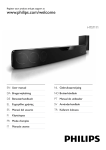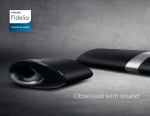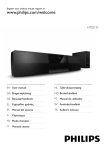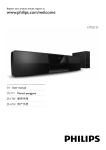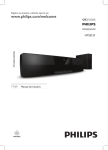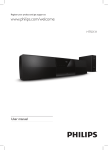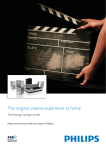Download Philips Home cinema speakers HTS7111
Transcript
Register your product and get support at www.philips.com/welcome HTS7111 EN User manual NL Gebruiksaanwijzing DA Brugervejledning NOBrukerhåndbok DE Benutzerhandbuch PT Manual do utilizador EL Εγχειρίδιο χρήσης SV Användarhandbok ES Manual del usuario TR Kullanım kılavuzu FI Käyttöopas FR Mode d’emploi IT Manuale utente 1 Help and support Tutorials FAQs Contact Philips 8 Wall mount and stand 4 4 4 4 2Notice 4 4 4 5 3Important 5 5 6 6 4 Your SoundBar 7 7 7 5 Connect your SoundBar 9 6 Use your SoundBar 14 14 15 15 16 7 Change settings 18 18 19 Compliance Mains fuse Trademarks Safety Care for your product Care of the environment Main unit Remote control Wall mount Stand for SoundBar and TV - STS1100/ STS1300 19 19 English Contents 20 9 Product specifications 20 10Troubleshooting 21 Subwoofer 9 Connectors 9 Connect to TV 10 Connect to other devices through HDMI 11 Connect audio from TV and other devices12 Listen to a connected device 13 Choose your sound MP3 player iPod or iPhone EasyLink Setup menu options and settings Apply factory settings EN 3 1 Help and support 2Notice Watch video tutorials and find answers to many frequently answered questions (FAQs) on your product at www.philips.com. This section contains the legal and trademark notices. Tutorials To set up your SoundBar and get additional information, refer to the video tutorials at www. philips.com/support. FAQs If you have a problem, refer to the frequently asked questions (FAQs) for this SoundBar at www.philips.com/support. If you still need help, contact Philips Consumer Care in your country. Warning •• Do not attempt to repair your SoundBar yourself. This may cause severe injury, irreparable damage to your SoundBar, or void your warranty. Contact Philips If you contact Philips, you will be asked for the model and serial number of your product. The model number and serial number are on the back or bottom of your product. Note the numbers before you call Philips: Model No. __________________________ Serial No. ___________________________ 4 EN Compliance This product is in compliance with the essential requirements and other relevant provisions of Directives 2006/95/EC (Low Voltage), 2004/108/ EC (EMC). Mains fuse This information applies only to products with a UK mains plug. This product is fitted with an approved molded plug. If you replace the fuse, use one with: • the ratings shown on the plug, • a BS 1362 approval, and • the ASTA approval mark. Contact your dealer if you are not sure about what type of fuse to use. Caution: To conform with the EMC directive (2004/108/EC), do not detach the plug from the power cord. Manufactured under license under U.S. Patent #’s: 5,451,942; 5,956,674; 5,974,380; 5,978,762; 6,487,535 & other U.S. and worldwide patents issued & pending. DTS and the Symbol are registered trademarks & DTS Digital Surround and the DTS logos are trademarks of DTS, Inc. Product includes software. DTS, Inc. All Rights Reserved. Manufactured under license from Dolby Laboratories. Dolby, Pro Logic, and the double-D symbol are trademarks of Dolby Laboratories. HDMI, the HDMI logo, and High-Definition Multimedia Interface are trademarks or registered trademarks of HDMI licensing LLC in the United States and other countries. 3Important Read and understand all instructions before you use your SoundBar. If damage is caused by failure to follow instructions, the warranty does not apply. Safety Risk of electric shock or fire! • Never expose the product and accessories to rain or water. Never place liquid containers, such as vases, near the product. If liquids are spilt on or into the product, disconnect it from the power outlet immediately. Contact Philips Consumer Care to have the product checked before use. • Never place the product and accessories near naked flames or other heat sources, including direct sunlight. •• Never insert objects into the ventilation slots or other openings on the product. •• Where the mains plug or an appliance coupler is used as the disconnect device, the disconnect device shall remain readily operable. •• Disconnect the product from the power outlet before lightning storms. •• When you disconnect the power cord, always pull the plug, never the cable. Risk of short circuit or fire! •• Before you connect the product to the power outlet, ensure that the power voltage matches the value printed on the back or bottom of the product. Never connect the product to the power outlet if the voltage is different. Risk of injury or damage to the SoundBar! •• For wall-mountable products, use only the supplied wall mount bracket. Secure the wall mount to a wall that can support the combined weight of the product and the wall mount. Koninklijke Philips Electronics N.V. bears no responsibility for improper wall mounting that results in accident, injury or damage. •• Never place the product or any objects on power cords or on other electrical equipment. EN 5 English Trademarks •• If the product is transported in temperatures below 5°C, unpack the product and wait until its temperature matches room temperature before connecting it to the power outlet. •• Parts of this product can be made of glass. Handle with care to avoid injury and damage. Risk of overheating! •• Never install this product in a confined space. Always leave a space of at least four inches around the product for ventilation. Ensure curtains or other objects never cover the ventilation slots on the product. Risk of contamination! • Do not mix batteries (old and new or carbon and alkaline, etc.). • Remove batteries if they are exhausted or if the remote control is not to be used for a long time. • Batteries contain chemical substances, they should be disposed of properly. Risk of swallowing batteries! • The product/remote control may contain a coin type battery, which can be swallowed. Keep the battery out of reach of children at all times! Care for your product Use only microfiber cloth to clean the product. Care of the environment Your product is designed and manufactured with high quality materials and components, which can be recycled and reused. When this crossed-out wheeled bin symbol is attached to a product it means that the product is covered by the European Directive 2002/96/ EC. Please inform yourself about the local separate collection system for electrical and electronic products. Please act according to your local rules and do not dispose of your old products with your normal household waste. Correct disposal of your old product helps to prevent potential negative consequences for the environment and human health. Your product contains batteries covered by the European Directive 2006/66/EC, which cannot be disposed with normal household waste. Please inform yourself about the local rules on separate collection of batteries because correct disposal helps to prevent negative consequences for the environmental and human health. 6 EN Remote control English 4 Your SoundBar Congratulations on your purchase, and welcome to Philips! To fully benefit from the support that Philips offers, register your SoundBar at www. philips.com/welcome. 2 Main unit 1 14 2 3 3 4 5 13 6 4 7 aSOURCE 8 b 9 Select an audio source for the SoundBar. c • • (Standby-On) Switch the SoundBar on or to standby. When the SoundBar is in standby, the standby indicator turns red. 10 +/- (Volume) Increase or decrease volume. 11 d Display panel 12 a • • (Standby-On) Switch the SoundBar on or to standby. When EasyLink is enabled, press and hold for at least three seconds to switch all connected HDMI CEC compliant devices to standby. EN 7 b HDMI SOURCE Switch your audio source to the HDMI connection. c DOCK for iPod Switch to Philips dock for iPod or iPhone. d Navigation buttons ( Navigate menus. / / / ) eOK Confirm an entry or selection. f SOUND SETTINGS Access or exit sound options. g Dock for iPod/iPhone buttons • (Stop)/EXIT: Stop play for iPod or • • • h iPhone, or exit the SoundBar setup menu. / (Previous/Next): Skip to the previous or next track or file. Press and hold to search backwards or forwards. (Play/Pause): Start, pause, or resume play. Press and hold to switch off the iPod or iPhone. Navigation button ( ): Return to the previous menu on the iPod or iPhone, or return to the previous SoundBar menu. (Mute) Mute or restore volume. i +/- (Volume) Increase or decrease volume. j TREBLE +/- Increase or decrease treble. k BASS +/- Increase or decrease bass. lAMBISOUND Select an Ambisound, auto or stereo mode. mSETUP Access the setup menu. n AUDIO SOURCE • OPTI IN: Switch your audio source to • • • 8 EN the optical connection. COAX IN: Switch your audio source to the coaxial connection. AUX: Switch your audio source to the AUX connection. MUSIC iLINK: Switch your audio source to the MUSIC iLINK connection. EasyLink controls With Easylink, you can control your SoundBar, TV and the connected devices with the standby button on your SoundBar remote control. • (Standby-On): Press and hold to switch your SoundBar, TV, and the connected devices to standby. 5 Connect your SoundBar Connect This section helps you connect your SoundBar to a TV and other devices. For information about the basic connections of your SoundBar and accessories, see the quick start guide. For a comprehensive interactive guide, see www.connectivityguide.philips.com. Setup Note •• For identification and supply ratings, refer to the type plate at the back or bottom of the product. •• Before you make or change any connections, make sure that all devices are disconnected from the power outlet. English Connect your subwoofer to your SoundBar as described in the quick start guide. Set up your subwoofer through the setup menu. Press SETUP repeatedly to select SUBW VOL on the display panel (see ‘Setup menu options and settings’ on page 18). Press OK. Press the Navigation buttons ( / ) to change the volume. Press OK to confirm. Press EXIT to exit the menu. 1 2 3 4 5 Connectors Subwoofer Connect other devices to your SoundBar. Follow the steps below to position, connect, and set up your subwoofer. Side left Position Place the subwoofer at least one meter (three feet) away from either to the left or right of your SoundBar, and ten centimeter away from the wall. For best results, place your subwoofer as shown below. MU SIC iLIN K MUSIC iLINK Audio input from an MP3 player. Rear left AC MAINS~ AC MAINS~ Connect to the power supply. EN 9 Connect to TV Rear center 6 COAXIAL DIGITAL IN 5 4 3 OPTICAL HDMI IN 1 L (WHITE) AUDIO IN-AUX 2 R (RED) HDMI OUT (ARC) TO TV DOCK for iPod a HDMI IN 1/2 Connect to the HDMI output on the audio devices. b TO TV-HDMI OUT (ARC) Connect to the HDMI input on the TV. c DOCK for iPod Connect to a Philips dock for iPod or iPhone.(Model: Philips DCK3060). d AUDIO IN-AUX Connect to an analog audio output on the TV or an analog device. Connect your SoundBar to a TV. You can listen to audio from TV programs through your SoundBar. Use the best quality connection available on your SoundBar and TV. Option 1: Connect to TV through HDMI (ARC) Your SoundBar supports HDMI version 1.4 - Audio Return Channel (ARC). If your TV is HDMI ARC compliant, connect your SoundBar to the TV through the HDMI ARC connection. With HDMI ARC, you do not need an additional audio cable to play audio from TV through your SoundBar. Using a High Speed HDMI cable, connect the HDMI OUT (ARC) connector on your SoundBar to the HDMI ARC connector on the TV. The HDMI ARC connector on the TV might be labeled HDMI IN or HDMI. For details on TV connectors, see the TV user manual. 1 e DIGITAL IN-OPTICAL Connect to an optical audio output on the TV or a digital device. TV f DIGITAL IN-COAXIAL Connect to a coaxial audio output on the TV or a digital device. Rear right 2 SUBWOOFER (6Ω) SUBWOOFER Connect to the supplied subwoofer. 10 EN 3 On your TV, turn on HDMI-CEC. For details, see the TV user manual. »» The audio from the TV is automatically played on your Soundbar. If audio from the TV does not play automatically, select the correct video input on the TV. English Option 2: Connect to TV through an analog audio cable TV If your TV does not have HDMI connectors, connect your SoundBar to the TV through an analog audio cable connection. Using an analog cable, connect AUX connectors on your SoundBar to the audio connectors on the TV. 1 TV 2 Select the correct video input on your TV. 3Press SOURCE on the SoundBar repeatedly to select the correct audio input (see ‘Listen to a connected device’ on page 13). Connect to other devices through HDMI 2 Connect digital devices directly to your SoundBar through an HDMI connection. Digital devices can include a Blu-ray player, set-top box, games console, or camcorder. Using a High Speed HDMI cable, connect the HDMI OUT connector on your digital device to the HDMI IN connector on your SoundBar. 3 1 Using another High Speed HDMI cable, connect the HDMI OUT (ARC) connector on your SoundBar to the HDMI IN or HDMI ARC connector on the TV. On the connected devices, turn on HDMICEC. For details, see the user manual of the devices. Select the correct video input on the TV. Select the correct HDMI input on your SoundBar (see ‘Set up audio for connected devices’ on page 13). 4 5 Note •• If you connect the HDMI OUT (ARC) connector on your SoundBar to an HDMI ARC compliant TV, you can either choose to select the audio to output through your SoundBar or through the TV. For details about mapping the TV audio, see the TV user manual. EN 11 Connect audio from TV and other devices Play audio from TV or other devices through your SoundBar. Use the best quality connection available on other devices. Option 2: Connect audio through a digital coaxial cable Good quality audio Using a coaxial cable, connect the COAXIAL connector on your SoundBar to the COAXIAL/ DIGITAL OUT connector on the device. The digital coaxial connector might be labeled DIGITAL AUDIO OUT. Note •• The audio connections in this user manual are only recommendations. You can use other connections too. •• When your SoundBar and TV are connected through HDMI ARC, an audio connection is not required. Option 1: Connect audio through a digital optical cable Best quality audio Using an optical cable, connect the OPTICAL connector on your SoundBar to the OPTICAL OUT connector on the device. The digital optical connector might be labeled SPDIF, SPDIF OUT, or OPTICAL. TV Tip •• To play video from the device, connect the device to the TV through a video connection. Option 3: Connect audio through analog audio cables Basic quality audio Using an analog cable, connect the AUX connectors on your SoundBar to the audio connectors on the device. VCR Tip •• To play video from the device, connect the device to the TV through a video connection. 12 EN When you connect a device to your SoundBar, check the audio settings. On your TV and other devices, turn on HDMI-CEC. For details, see the user manual of the TV and the other device. Select ‘Amplifier’ from the TV speakers menu. For details, see the TV user manual. On your SoundBar, turn on System Audio Control, and then map the audio of the connected device to the correct connectors on your SoundBar (see ‘Play audio from SoundBar’ on page 17). If the connected device is not HDMI-CEC compliant, press the source button on the main unit or remote control to select the correct audio input on your SoundBar (see ‘Listen to a connected device’ on page 13). 1 2 3 Listen to a connected device Before you can listen to a connected device, select the source for the device. Main unit Press SOURCE on the SoundBar to cycle through and select one of the following audio sources on the display panel: HDMI ARC (if avaliable) > HDMI IN1 > HDMI IN2 > MUSIC I-LINK > IPOD > AUX > OPTI IN > COAX IN Remote control Press AUDIO SOURCE or HDMI SOURCE on the remote control to cycle through and select an audio source, as shown in the following table. Source button Display text AUDIO SOURCE OPTI IN AUDIO SOURCE COAX IN Audio source Optical input Coaxial input AUX input MP3 input AUDIO SOURCE AUX AUDIO SOURCE MUSIC I-LINK HDMI SOURCE HDMI ARC (if HDMI available) ARC output HDMI SOURCE HDMI IN1 or HDMI HDMI IN2 input Note •• HDMI ARC can only be selected if you connect your SoundBar to the HDMI ARC compliant TV through HDMI ARC (see ‘Option 1: Connect to TV through HDMI (ARC)’ on page 10). EN 13 English Set up audio for connected devices 6 Use your SoundBar This section helps you use the SoundBar to play audio from connected devices. Before you start • Make the necessary connections described in the quick start guide and the user manual. • Switch the SoundBar to the correct source for other devices. Choose your sound This section helps you choose the ideal sound for your video or music. Sound options and settings Sound option MODE AUTO VOL NIGHT AUD SYNC Setting for the option AUTO MOVIE MUSIC ORIGINAL NEWS GAMING ON OFF ON OFF 0 MS, 10 MS, 20 MS, ..., 180 MS, 190 MS, 200 MS 1Press SOUND SETTINGS repeatedly to access the sound options on the display panel (see ‘Sound options and settings’ on page 14). Select a setting, and then press OK. Press the Navigation buttons ( / ) to select an option. Press EXIT to exit. If you do not press a button within ten seconds, the menu exits automatically. 2 3 4 14 EN Sound mode Select predefined sound modes to suit your video or music. Press SOUND SETTINGS repeatedly to select MODE on the display panel (see ‘Sound options and settings’ on page 14). Select a mode, and then press OK. Press the Navigation buttons ( / ) to select a setting: • AUTO: Select either MOVIE or MUSIC automatically depend on the sound stream. • MOVIE: Enjoy a cinematic audio experience, specially enhanced for movies. • MUSIC: Recreate the original recording environment of your music, in the studio or at a concert. • ORIGINAL: Experience the original sound of your movies and music, without added sound effects. • NEWS: Hear every word with optimized speech and clear vocals. • GAMING: Enjoy thrilling arcade sounds, ideal for action-packed video games or loud parties. 1 2 3 Auto volume Turn the auto volume on to keep the volume constant when you switch to a different source. Press SOUND SETTINGS repeatedly to select AUTO VOL on the display panel (see ‘Sound options and settings’ on page 14). Press OK. Press the Navigation buttons ( / ) to select a setting: • ON: Turn on auto volume. • OFF: Turn off auto volume. 1 2 3 Equalizer For quiet listening, decrease the volume of loud sounds when you play discs. Night mode is only available for Dolby encoded DVD and Blu-ray discs. Press SOUND SETTINGS repeatedly to select NIGHT on the display panel (see ‘Sound options and settings’ on page 14). Press OK. Press the Navigation buttons ( / ) to select a setting: • ON: Turn on night mode. • OFF: Turn off night mode. Change the high frequency (treble) and low frequency (bass) settings of the SoundBar. Press TREBLE +/- or BASS +/- to change the frequency shown on the display panel. 1 2 3 Note •• If auto volume is set to ON, you cannot enable the night mode. Synchronize picture and sound If the audio and video are not synchronized, delay the audio to match the video. Press SOUND SETTINGS repeatedly to select AUD SYNC on the display panel (see ‘Sound options and settings’ on page 14). Press OK. Within two seconds, press the Navigation buttons ( / ) to change the delay shown on the display panel. Press OK to confirm. 1 2 3 4 MP3 player Connect your MP3 player to play your audio files or music. What you need • An MP3 player. • A 3.5mm stereo audio cable. Play music 1 Connect the MP3 player to the SoundBar as described in the Quick start guide. Press AUDIO SOURCE repeatedly to select MUSIC I-LINK on the display panel. Press the buttons on the MP3 player to select and play audio files or music. 2 3 iPod or iPhone When you connect a Philips dock for iPod/iPhone, you can use the SoundBar to play music, movies and photos from your iPod or iPhone. What you need • A Philips dock (Model: Philips DCK3060). • A yellow composite cable. Ambisound Set up Ambisound to give the best surround sound effect. Press AMBISOUND repeatedly to select a setting on the display panel: • AMBISOUND: Surround sound for your room (see ‘Ambisound’ on page 18). • STEREO: Two-channel stereo sound. Ideal for listening to music. • AUTO: Surround sound based on the audio stream. Note •• If you play a source with DTS, DTS is displayed on the display panel for two seconds. •• If you play a source with Dolby, DOLBY D is English Night mode Note •• Philips dock for iPod or iPhone is sold separately. •• Charge your iPod or iPhone on the dock while the SoundBar is in iPod mode. Dock your iPod or iPhone 1 Move the slide at the bottom of the dock to STANDARD, and then connect the dock to the SoundBar. Connect the yellow composite cable to the dock and TV. Switch on the iPod or iPhone, and place it on the dock. 2 3 displayed on the display panel for two seconds. EN 15 EasyLink Play music 1 2 Dock your iPod or iPhone (see ‘Dock your iPod or iPhone’ on page 15). Press DOCK for iPod. »» IPOD appears on the display panel. 3 Press the play buttons to control play. Button Action Navigation buttons ( / ) OK / (Previous/ Next) (Play/ Pause) Navigate up and down the menus. (Stop)/EXIT Navigation button ( ) Confirm an entry or selection. Skip to the previous or next track or file. Press and hold to search backwards or forwards. Start, pause, or resume play. Press and hold to switch off the iPod or iPhone. Stop play for iPod or iPhone, or exit the SoundBar setup menu. Return to the previous menu on the iPod or iPhone, or return to the previous SoundBar menu. Play video and slideshows 1 2 3 4 On iPod, enable the TV ON setting. On iPhone, select the TV Out option. Dock your iPod or iPhone (see ‘Dock your iPod or iPhone’ on page 15). Press DOCK for iPod. Switch the TV to the AV/VIDEO source (corresponding to the yellow composite cable). »» The TV screen goes blank. 5 6 Browse on the iPod or iPhone screen to select videos or photos. Press (Play/Pause) on the SoundBar remote control to play the videos or photos. »» The picture is displayed on the TV. 16 EN The SoundBar supports Philips EasyLink, which uses the HDMI-CEC (Consumer Electronics Control) protocol. EasyLink-compliant devices that are connected through HDMI can be controlled by a single remote control. Philips does not guarantee 100% interoperability with all HDMI-CEC devices. What you need • HDMI-CEC compliant devices. • An HDMI connection between the connected devices. Switch on 1 Switch on the HDMI-CEC operations on the TV and other connected devices. For information, see the manual of the TV or other devices. Press SETUP repeatedly to select EASYLINK on the display panel (see ‘Setup menu options and settings’ on page 18). Press OK. Press the Navigation buttons ( / ) to select ON. Press OK to confirm. »» The EasyLink is on. 2 3 4 5 Note •• To disable EasyLink, select OFF. •• When EasyLink is switched off, the following options are not available: SYS STBY, AUD CTRL, and TV AUDIO. Play audio from SoundBar Control the SoundBar and the other connected HDMI-CEC compliant devices with a single remote control. You need to connect an HDMI-CEC device to the TV and route its audio output from TV to the SoundBar in order to map the audio of the connected device to your SoundBar. Press SETUP repeatedly to select AUD CTRL on the display (see ‘Setup menu options and settings’ on page 18). Press OK. Press the Navigation buttons ( / ) to select ON, and then press OK. • To play the audio from the TV speakers, select OFF. Press SETUP repeatedly to select TV AUDIO on the display panel, and then press OK. Press the Navigation buttons ( / ) to select the audio output for each connected device. • HDMI ARC: Audio output through the HDMI ARC connection. • COAX IN: Audio output through the coaxial connection. • OPTI IN: Audio output through the optical connection. • AUX: Audio output through the AUX connection. Press OK to confirm. Press EXIT to exit the menu. One-touch standby When you press and hold (Standby) on the remote control, the SoundBar and all the connected HDMI-CEC devices (that support one-touch standby) switch to the standby mode. If One-touch standby is enabled on your SoundBar, you can switch to standby with the remote control of the TV or other connected HDMI-CEC devices. System Audio Control You need to connect a device to the TV and route its audio output from TV to the SoundBar so that the SoundBar can switch to the corresponding audio source automatically. To use one-touch audio, switch on System Audio Control and map connected devices to the audio input connectors of the SoundBar. TV Audio Mapping You need to connect a device to the TV and route its audio output from TV to the SoundBar in order to map the device to the audio input connector (see ‘Play audio from SoundBar’ on page 17). One-touch standby The SoundBar and all connected HDMI-CEC devices can be switched to standby by a remote control. Press SETUP repeatedly to select SYS STBY on the display panel (see ‘Setup menu options and settings’ on page 18). Press OK. Press the Navigation buttons ( / ) to select ON. Press OK to confirm. Press EXIT to exit the menu. 1 1 2 3 4 5 6 7 Note •• HDMI ARC can only be selected if you connect your SoundBar to the HDMI ARC compliant TV through HDMI ARC connection (see ‘Option 1: Connect to TV through HDMI (ARC)’ on page 10). 2 3 4 5 Note •• To disable One-touch standby, select OFF. EN 17 English Control devices 7 Change settings 1Press SETUP repeatedly to cycle through This section helps you to change the settings of your SoundBar. 2 3 Caution the options on the display panel (see ‘Setup menu options and settings’ on page 18). Select an option, and then press OK. Press the Navigation buttons ( / ) to select a setting for the option, and then press OK. •• Most of the settings are already configured with the best value for your SoundBar. Unless you have a reason to change a setting, it is best to leave it at the default value. Note •• If you do not press a button within ten seconds, the setup menu exits. Setup menu options and settings Setup menu option EASYLINK Setting for the Setting for option the option ON OFF SYS STBY ON OFF AUD CTRL ON OFF TV AUDIO HDMI ARC COAX IN OPTI IN AUX SUBW VOL +5, +4, +3, ..., 0, ..., -3, -4, -5 AMBISOUND POSITION IN FRONT RIGHT LEFT CORNER DISTANCE 0M - 2M 2M - 3M ABOVE 3M DISPLAY BRIGHT DIM 1 DIM 2 18 EN •• To return to the previous menu, press the Navigation button ( press EXIT. ). To exit the menu, Ambisound To give the best surround sound effect, select options about your room and the position of the SoundBar. Press SETUP repeatedly to select AMBISOUND on the display panel (see ‘Setup menu options and settings’ on page 18). Press OK. Set the position of the SoundBar. 1 2 3 APress the Navigation buttons ( / ) to select POSITION, and then press OK. BPress the Navigation buttons ( / ) to select IN FRONT, RIGHT, LEFT, or CORNER, and then press OK. Set the distance between your listening position and the SoundBar. 4 APress the Navigation buttons ( / ) to select DISTANCE, and then press OK. BPress the Navigation buttons ( / ) to select 0M - 2M (from zero to two meters), 2M - 3M (from two to three meters), or ABOVE 3M (above three meters), and then press OK. Change the brightness of the SoundBar display panel. Press SETUP repeatedly to select DISPLAY on the display panel (see ‘Setup menu options and settings’ on page 18). Press OK. Press the Navigation buttons ( / ) to select BRIGHT, DIM 1, or DIM 2, and then press OK. 1 2 3 Apply factory settings You can reset your SoundBar to the default settings programmed at the factory. In AUX mode, within three seconds, press TREBLE+, VOL-, and BASS+. »» When the factory settings restore is complete, the SoundBar automatically switches off and restarts. 8 Wall mount and stand English Display panel Before you mount your SoundBar to the wall or onto a single stand, read all safety precautions (see ‘Safety’ on page 5). If you have any query, contact Philips Consumer Care in your country. Wall mount Screw length/diameter Depend on the type of wall mounting this wall mount bracket, make sure that you use screws of a suitable length and diameter. 3 - 3.5mm > 25mm Note •• Before wall mount, you can remove the three rubber feet at the bottom of the SoundBar. •• If you remove the rubber feet, you cannot stick them back on the bottom of the SoundBar. For information about how to wall your SoundBar, see the wall mount guide. EN 19 Stand for SoundBar and TV STS1100/STS1300 If you have a Philips TV, you can mount your SoundBar and the TV onto a single stand. Purchase the STS1100 or STS1300 stand from an authorized Philips dealer. For instructions on how to install the stand with the SoundBar and Philips TV, see the stand quick start guide. STS1100: 9Product specifications Note •• Specifications and design are subject to change without notice. Amplifier • • • • Total output power: • Europe and Asia: 300W RMS (30% THD) • Latin America: 224W RMS (10% THD) Frequency response: 20 Hz-20 kHz / ±3 dB Signal-to-noise ratio: > 65 dB (CCIR) / (A-weighted) Input sensitivity: • AUX: 250 mV • Music iLink: 50 mV Audio • STS1300: Main unit •• •• •• •• •• •• •• 20 EN S/PDIF Digital audio input: • Coaxial: IEC 60958-3 • Optical: TOSLINK Power supply: 110-240 V~, 50-60 Hz Power consumption: 55 W Standby power consumption: ≤ 1 W Center speaker: • Speaker impedance: 6 ohm • Speaker drivers: 2 x 64 mm (2.5”) full range • Frequency response: 150 Hz-20 kHz Front/Rear speakers: • Speaker impedance: 3 ohm • Speaker drivers: 4 x 64 mm (2.5”) full range • Frequency response: 150 Hz-20 kHz Dimensions (WxHxD): 945 x 108 x 86 mm Weight: 3.82 kg • • • • • • • Output power: 80W RMS (30% THD) Impedance: 6 ohm Speaker drivers: 165 mm (6.5”) woofer Frequency response: 20 Hz-150 Hz Dimensions (WxHxD): 192 x 447 x 253 mm Weight: 4.4 kg Cable length: 3 m Wall mount •• •• Dimensions (WxHxD): 80 x 80 x 15 mm Weight: 0.08 kg/each Remote control batteries • 2 x AAA-R03-1.5 V 10Troubleshooting English Subwoofer Warning •• Risk of electric shock. Never remove the casing of the product. To keep the warranty valid, never try to repair the product yourself. If you have problems using this product, check the following points before you request service. If you still have a problem, register your product and get support at www.philips.com/welcome. Main unit The buttons on the SoundBar do not work. • Disconnect the SoundBar from the power supply for a few minutes, then reconnect. Sound No sound from SoundBar speakers. • Connect the audio cable from your SoundBar to your TV or other devices. However, you do not need a separate audio connection when: • the SoundBar and TV are connected through HDMI ARC connection, or • a device is connected to the HDMI IN connector on your SoundBar. • Set up the audio for the connected device (see ‘Set up audio for connected devices’ on page 13). • Reset your SoundBar to its factory settings (see ‘Apply factory settings’ on page 19), and then switch it off and switch on again. • On your SoundBar, press SOURCE repeatedly to select the correct audio input on the display panel. • Make sure that the SoundBar is not muted. Press to select MUTE OFF on the display panel. Distorted sound or echo. • If you play audio from the TV through the SoundBar, make sure that the TV is muted. Audio and video are not synchronized. • 1) Press SOUND SETTINGS repeatedly to select AUD SYNC on the display panel, and then press OK. 2) Within two seconds, press the Navigation buttons ( / ) to change the delay shown on the display panel. 3) Press OK to confirm. EN 21 Play When you switch on the TV, the SoundBar automatically switches on. • This behavior is normal when you are using Philips EasyLink (HDMI-CEC). To make the SoundBar work independently, switch off EasyLink. EasyLink does not work. • Make sure that the SoundBar is connected to a Philips brand EasyLink TV, and the EasyLink option is turned on (see ‘Switch on’ on page 16). Cannot play video or photos from an iPod or iPhone on the TV. • Browse and select videos and photos from the iPod or iPhone screen, and play them on your TV. • Make sure that the iPod or iPhone software has not been tampered with or illegally modified. Cannot view pictures from an iPod or iPhone on the TV. • Connect a yellow composite cable to the iPod dock and the TV. • Switch the TV to the AV/VIDEO source (corresponding to the yellow composite cable). • Press the play button on the iPod or iPhone to start a slideshow. • Make sure that the iPod or iPhone software has not been tampered with or illegally modified. 22 EN © 2011 Koninklijke Philips Electronics N.V. All rights reserved. sgptt_1131/12_v2 book1 back page.indd 4 12/29/2010 3:28:13 PM























